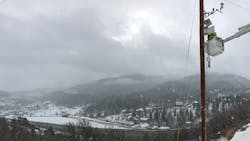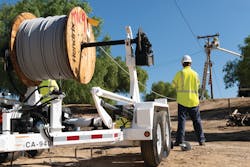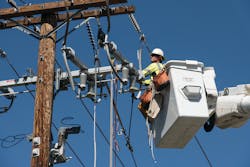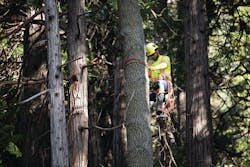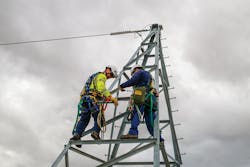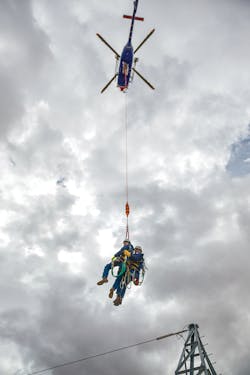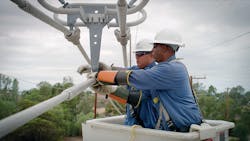Nearly 3,000 California wildfires scorched almost 20,000 acres in the first six months of 2020, according to CAL FIRE. California’s wildfire season may typically span from May to October, but Southern California Edison (SCE) involves its linemen in its mitigation efforts all year.
“SCE is a beehive of activity year-round focused on wildfire mitigation,” said Cameron McPherson, senior manager of grid resiliency for SCE. “The majority of these field activities require the relentless hard work and experience of our electrical workers. We would not be successful without their tireless efforts and dedication.”
Like other California utilities, SCE was required to file a Wildfire Mitigation Plan (WMP), and linemen play a critical role in the mitigation efforts outlined in this plan, said Steve Sprague, SCE’s interim region manager of North Coast. Due to the nature of their jobs, linemen must require proficiency on the latest construction standards, the most up-to-date tools and the newest processes available to them. They also must provide assistance and critical information to the support organizations, including SCE’s Incident Management Team, Fire Management team, along with Damage Assessment Teams throughout an incident. Finally, by coaching and mentoring their crew members, linemen can help to provide safe and reliable service to SCE’s customers and communities.
“Their knowledge and experience from their years of performing line construction work provides them the expertise to perform the critical work of service restoration in a safe and professional manner to customers and our communities,” Sprague said. “Linemen are key players in SCE’s approach to proactively mitigating wildfires through the inspection and reporting process to identify equipment, facilities or conditions, which might need repair or replacement.”
McPherson expects to have a challenging fire season for the remainder of 2020.
“Late winter and spring rains kept live fuel moisture at relatively high levels until the beginning of June, and fuels are now rapidly drying out with some record-breaking heat,” McPherson said. “Above normal temperatures are expected through the rest of the year. Additionally, the COVID-19 situation has introduced another layer of complexity that we are dealing with.”
Proactive Planning in California
SCE has been powering California for more than 130 years, and its service area spans 50,000 square miles. This territory features a diverse blend of assets, geography, weather, fuel conditions, jurisdictional authorities and environmental conditions.
“System hardening efforts such as covered conductor deployment is a cornerstone of our program,” McPherson said. “However, the diversity of our service territory requires a more dynamic multi-pronged approach. One of our best practices is the balanced approach to wildfire mitigation where we leverage a set of methods across our foundational strategies of grid hardening, enhanced operational practices and more granular situational awareness.”
SCE’s foundational activities include installing covered conductor in place of bare wires and inspecting overhead transmission and distribution lines and equipment—both from the ground and aerially via helicopter and drone. In addition, SCE focuses on pruning vegetation, removing hazard trees, installing additional weather stations for enhanced situational awareness and the activities around reducing the impacts of Public Safety Power Shutoffs (PSPS) on its customers.
SCE’s strategy and tactics change with the evolving wildfire and climate change threats. For example, the utility shifted from a compliance-oriented framework to a risk-informed framework to focus its efforts on the areas and structures with the highest risks. Also, the utility has enhanced its situational awareness. By better understanding what is happening in the environment around its assets and how it affects operations, SCE can more effectively assess system risk. These risk assessments help SCE to stage or tier its operational practices—such as blocking reclosers and enabling fast-curve settings—commensurate with the threat to its system and the communities it serves.
“The best strategy is likely a risk-informed one with a balanced suite of tactics, including grid hardening, enhanced situational awareness, and advanced operational practices, all while keeping a close eye on new and advanced technologies to advance innovative solutions,” McPherson said.
Some of SCE’s challenges stem from its vast array of overhead assets in high fire risk areas, which include more than 300,000 structures connecting about 14,000 circuit miles of conductor in areas at an elevated risk for wildfire.
“Analyzing the problem through a risk-informed lens enables us to focus our workforce on the equipment that needs the most attention, and in the areas most susceptible to ignitions,” McPherson said. “Using a risk-informed strategy to plan grid hardening, inform operational strategies and deploy situational awareness tools helps us better tackle the challenges that come with a vast expanse of assets in high fire risk areas.”
SCE has always embraced the use of new technology to improve the operation of the system. Today, the utility has a vast array of field-deployed technologies to help prevent and mitigate the risk of wildfires. For example, SCE currently operates a dense network of automatic reclosers, nearly all of which can be remotely operated, and many of them are configured to intervene much more quickly to reduce fault current.
Enhanced situational awareness, primarily through a dense network of weather stations and high-definition cameras, represent the utility’s latest and most transformational change.
“The data from this system is now being used to make operations more efficient and effective, assess risk at the circuit level, and refine our weather modeling and forecasting,” McPherson said. “Most exciting are the new technologies we are currently piloting, which include Distribution Fault Anticipation, Open Phase Detection and Rapid Earth Fault Current Limiting (REFCL) devices, all which seek to reduce ignitions.”
In addition, he said harnessing the power of big data, artificial intelligence and machine learning will be critical in improving mitigation effectiveness, more accurately assess risk, and move some of these advanced fault detection technologies into the fault anticipatory realm.
Employing New Mitigation Strategies
Another California utility — San Diego Gas & Electric (SDG&E) — is actively preparing for the upcoming wildfire season through situational awareness, grid hardening, vegetation management, asset inspections and community outreach.
“For over a decade, we have prepared for each upcoming wildfire season with a sense of urgency,” said Jonathan Woldemariam, director of wildfire mitigation and vegetation management for SDG&E. “This leads to continuous development and improvement of our wildfire mitigation efforts.”
To prepare for the 2020 wildfire season, SDG&E used a combination of new strategies including strategic undergrounding portions of its service territory, covered conductor, grid reconfiguration and continued accelerated overhead hardening. This work was developed by a special team that evaluated every grid portion with the goal to reduce the impacts of PSPS. This work should result in a 30% reduction in the number of customers impacted by PSPS compared to 2019. The use of microgrids will also allow the company to keep more customers energized during a PSPS.
“SDG&E is projecting a 30% reduction of customer impacts due to PSPS by undergrounding, adding more weather stations and sectionalizing devices to be more surgical with PSPS,” Woldemariam explained.
For example, SDG&E’s linemen are performing a significant amount of asset inspection and repair work to maintain the grid. At times, using more than 40 drones, the drone pilots and qualified electrical workers conducted year-round aerial inspections of power and gas lines, which has significantly reduced the risk of equipment failures in SDG&E’s highest fire areas. To date, SDG&E has assessed more than 30,000 poles through drones in its highest risk areas. Additionally, four helicopters help with wildfire safety and the patrolling electrical lines.
“Their work is vital to ensuring our equipment is operating as designed and will not become a potential source of ignition,” Woldemariam said. “Linemen play an important role in patrolling and inspecting lines after a PSPS event, to ensure the infrastructure is safe to operate prior to restoration of power and they also complete repairs if damage is found from a high wind event.”
The linemen are well versed on protocols for working in areas of the highest fire risk, and they understand when dedicated fire patrols and qualified firefighters are required to be on the job site. SDG&E enhances the ability of its crews to suppress fire at its earliest stages by assigning designated Fire Patrols as well as training all personnel to establish good fire safety protocols.
“All linemen have a role and responsibility in wildfire prevention,” Woldemariam says. “It starts with understanding their utility’s wildfire prevention plan and the mitigation measures required when elevated risk conditions exist.”
As part of this proactive approach, SDG&E’s linemen are hardening transmission and distribution systems with targeted mitigations including overhead, underground and covered conductor installations. In 2020, SDG&E plans to harden 235 miles of infrastructure to mitigate wildfire risk. SDG&E’s grid hardening includes replacing specific assets in the High Fire Threat District with assets, which reduce ignition risk such as SCADA capacitors, CalFire-approved fuses and lightning arrestors.
SDG&E’s falling conductor protection mitigates or reduces the potential for a fire ignition. The system operates so quickly that it can detect and de-energize the conductor before it even hits the ground. SDG&E has also deployed high-speed relays that reduce the amount of energy into a fault, which reduces the likelihood of an ignition.
In addition, SDG&E has more than 190 weather stations providing readings on wind speed, humidity and temperature. More than 100 cameras monitor SDG&E’s service territory for severe weather and fires.
“The cameras, paired with sectionalizing switches, allow SDG&E to be more precise on only turning off the most endangered communities. Also, artificial intelligence-based new predictive models increase the accuracy of the weather forecast to help prevent wildfires and allow the company to further mitigate impacts to customers,” said Brian D’Agostino, director of fire science and climate adaptation for SDG&E.
Another proactive strategy for wildfire mitigation is a focus on vegetation management. More than 455,000 trees have been inspected and trimmed near SDG&E power lines, and a 25-ft clearance for certain high-risk tree species is required. In addition, a new vegetation risk index analyzes data from hundreds of thousands of trees, historical power outages and historical weather data to help to prevent tree-related outages and tree-related ignitions before they even happen.
“SDG&E continues to innovate and improve our approach based on lessons learned from previous fire seasons,” Woldemariam said. “Some of the innovative tools include the use of fire propagation models to understand fire behavior for specific areas within our service territory, using a vegetation risk index to evaluate the tree strike risk, and leverage weather information to forecast specific fire potential days.”
After several PSPS events in recent years, SDG&E recognized the importance of balancing the mitigation of wildfire risk and the customer impacts from PSPS events. To address this challenge, SDG&E formed a PSPS Mitigation Engineering Team to perform a circuit-by-circuit analysis and determine the best mitigation for each scenario. In addition, the 2020 Wildfire Mitigation Plan introduced several new and expanded programs including Customer Resiliency, Generator Grant Program, Whole Home Generator Program and Microgrids. Specifically, all medical baseline customers who experienced a PSPS in 2019 will be offered a portable generator. SDG&E will be offering 300 whole home generators to certain customers as well as 1,000 significantly subsidized generators for others.
To further support community outreach, SDG&E employs an annual comprehensive wildfire safety public education campaign. This program includes hosting Wildfire Safety Fairs and Wildfire Resiliency Open House Webinars and drive-thru services at the Community Resource Centers during PSPS events to maintain safe-distancing during the pandemic. SDG&E also partners with more than 400 community-based organizations and public safety partners in order to share important information with the communities it serves.
For 2020, fuel moistures were above normal to start the summertime due to significant springtime rainfall, but the moisture is falling rapidly.
“We are expected to become critically dry by summer’s end,” D’Agostino said. “As seen just about every year, periods of critical fire weather, driven by Santa Ana winds, are expected to return this fall.”
Waging War Against Wildfires in the West
In regard to its wildfire mitigation system hardening efforts, Rocky Mountain Power is leveraging technology in a number of areas within the high fire-risk area in its service territory in Utah, Wyoming and Idaho.
Over the last year, Rocky Mountain Power, a division of PacifiCorp, invested in new covered overhead wire to prevent sparks from occurring when debris or branches fall into the line and weather monitoring stations for deeper insight into weather-related threats — both real-time and historic.
In addition, operations teams are also using drones to assist in wildfire mitigation efforts. Those drones incorporate the use of infrared (IR) camera technology as well as regular video. The IR camera can detect hot spots, such as electrical connections that have poor contact resistance causing heating and address those issues proactively.
Also, the company recently released an easy-to-use interactive map to view areas where a PSPS may occur. In these rare instances, power could be proactively shut off in specific, high-risk areas to prevent wildfire ignitions. Customers can see if a home or business is in a potential PSPS area and view the seven-day status forecasts in these designated zones.
Oregon-based Pacific Power, which is also part of PacifiCorp, has also implemented similar strategies for wildfire mitigation. For example, the utility is investing in covered overhead wire and installing dozens of weather-monitoring stations and clearing vegetation throughout high-risk wildfire areas. In addition, the utility is ensuring public safety through coordination with state and local government officials, forestry management groups and other stakeholders.
Through a proactive — rather than a reactive — approach to wildfires, utilities are maximizing the impact of their mitigation strategies. By involving their linemen in their system hardening and mitigation efforts, they are helping to strengthen their fight against wildfires in their service territories.
In the Wake of Wildfires: SDG&E Shares Best Practices
SDG&E trains all of its linemen on its Operations and Maintenance Wildland Fire Prevention Plan. The utility reviews the details of this standard practice with its workforce throughout the fire season with an emphasis on risk mitigation based on the planned work activity and the daily Fire Potential Index. The annual training includes basic wildland fire prevention training and usage of required fire tools and equipment to suppress small fires.
Some of the safeguards in place to protect crews during repairs and power restoration include communication with fire coordinators monitoring fire activity, collaborating with on-scene first responders and working within the Incident Command System to account for crew resources assigned to the fire incident. On-site SDG&E field leadership ensure crews have the necessary personal protective equipment, water, shade and other equipment required to safely restore power to customers.
SDG&E personnel are committed to following a three-step process for reducing the fire risk and exposure involved with potential wildland fires related to its work activities or equipment that include fire prevention, immediate or early fire detection and rapid extinguishment.
1. Fire Prevention. All work activities taking place in the wildland areas of SDG&E’s service territory will be assessed with regard to fire risk during standard safety tailboard sessions. The utility will exclude those activities that pose risk if possible. Those that cannot be eliminated will incorporate appropriate mitigation measures to reduce the risk where possible.
2. Immediate or Early Fire Detection. SDG&E enhances the ability of its crews to detect any fire ignition at its earliest stages by assigning designated (co-lateral duty) and dedicated Fire Patrols (sole duty) as well as training all personnel to establish good situational awareness during “Normal,” “Elevated” and “Extreme” operating conditions.
3. Rapid Extinguishment. Prescribed fire tools and equipment will be available within 50 ft of high-risk work to improve the linemen’s or the contract firefighter’s ability to prevent the start of any fire. The emphasis will be on wildland fires, especially during the critical times of the year when the fire risk is high.
SCE’s Six Strategies for Wildfire Mitigation and Response
In recent years, the North Coast region for Southern California Edison (SCE) has experienced some of the largest wildfire events including the Thomas Fire (2017), Woolsey Fire (2018), and the Maria Fire (2019). These events have changed the way the utility prepares for and responds to wildfires. Here are some strategies the utility has used to safeguard its field workforce, restore power and keep its communities safe.
1. Identify Hazards. Every job starts with the foremen and crew members discussing the hazards of the project and the steps they will take to eliminate or overcome those hazards during their tailboard discussion, said Don Arnold, senior manager of Edison field safety. The Fire Management team works closely with the Fire Command(s) in charge of the specific wildfire to assure the wildfire is clear of an area to allow the crews to safely move in to start the process of clean up, rebuild the electrical infrastructure and restore power.
2. Focus on Communication. SCE’s Incident Management Team monitors wildfire smoke hazards in the areas their crews are working to ensure the levels are safe to work. Continued communications with crew members on possible hazards supervisors and safety advisors are observed during operations. Daily morning briefings provide an opportunity to discuss the latest safety concerns and reminders, including possible backfeed issues, test and apply personal grounds, tripping hazards, bees/insects, and other hazards the crews may be facing that day.
3. Implement New Standards. SCE has instituted standard changes for high-fire areas such as covered overhead conductor, composite poles, fire-wrapped wood poles and ridge pin construction in many areas. “Some of the biggest changes we have seen come out of wildfire events are the approach to not only the reconstruction of our facilities from the event itself but those changes we incorporate into our everyday work,” Steve Sprague said.
4. Strengthened the Incident Management Team Concept. With additional training, SCE’s IMT is now prepared to assist in wildfire events to ensure proper oversight and coordination between all entities involved in an event. The IMT has allowed SCE to partner with local, state and federal entities to ensure proper coordination between all agencies prior to, during and after an incident.
5. Installed New Weather Stations and Cameras. SCE has also added this technology not only in North Coast, but throughout the company to better proactively monitor conditions prior to an ignition. SCE’s Public Safety Power Shutoff’s (PSPS) incident teams also play a large role in the prevention of future events. The preparations are rigorous across the board with increased efforts focused on enhancements to PSPS. SCE has refined its approach to PSPS based on lessons learned from 2019 and feedback from the customers, communities and stakeholders, while simultaneously trying to mitigate the effects of outages on customers during the pandemic.
6. Adding New Inspection Processes. SCE has also implemented new inspection processes such as aerial inspections to enhance its proactive enhanced inspection process.
About the Author
Amy Fischbach
Electric Utilities Operations
Amy Fischbach is the Field Editor for T&D World magazine and manages the Electric Utility Operations section. She is the host of the Line Life Podcast, which celebrates the grit, courage and inspirational teamwork of the line trade. She also works on the annual Lineworker Supplement and the Vegetation Management Supplement as well as the Lineman Life and Lineman's Rodeo News enewsletters. Amy also covers events such as the Trees & Utilities conference and the International Lineman's Rodeo. She is the past president of the ASBPE Educational Foundation and ASBPE and earned her bachelor's and master's degrees in journalism from Kansas State University. She can be reached at [email protected].
